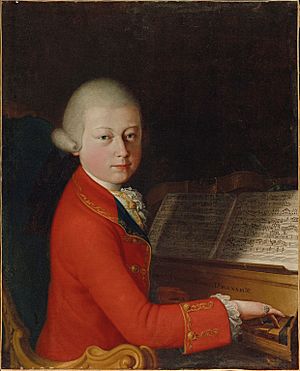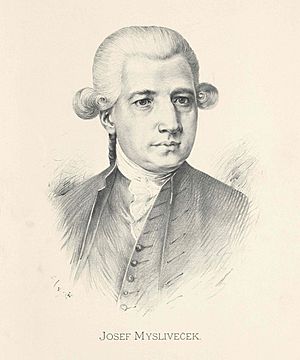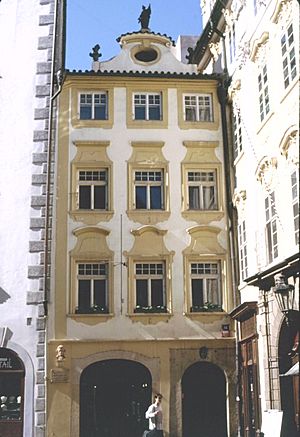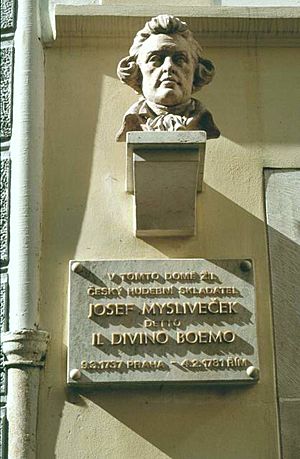Josef Mysliveček facts for kids
Josef Mysliveček (born March 9, 1737 – died February 4, 1781) was a famous Czech composer. He helped shape the music style of the late 1700s, known as the Classical period. Mysliveček was a good friend to the younger Wolfgang Amadeus Mozart and his father, Leopold Mozart. He influenced Mozart's music, especially his symphonies, Italian serious operas, and violin concertos. The Mozarts often wrote about him in their letters.
Contents
Life Story
Josef Mysliveček was born in Prague. He was one of two twin sons of a rich mill owner. He first studied philosophy at Charles-Ferdinand University. Later, he followed his father's path and became a master miller in 1761. However, he soon left the family business to study music.
In Prague, he studied how to compose music with Franz Habermann and Josef Seger. In 1763, he traveled to Venice, Italy, to study with Giovanni Pescetti. His family and a nobleman named Vincenz von Waldstein helped him pay for his trip.
In Italy, people called him Il Boemo, which means "the Bohemian." They also called him Venatorino, meaning "the little hunter," because his last name, Mysliveček, means "little hunter" in Czech. In 1771, he became a member of the Accademia Filarmonica di Bologna, a famous music academy.
Unlike many composers of his time, Mysliveček never worked for one specific noble or ruler. He liked to be free to move around. He made money by teaching, performing, and writing music. Rich fans often gave him gifts.
After arriving in Italy in 1763, Mysliveček rarely left. He visited Prague in 1767–68, Vienna in 1773, and stayed in Munich from 1776 to 1778. His visits to Prague led to several of his operas being performed there. He was asked to write an opera for the carnival season in Munich in 1777, called Ezio.
Mysliveček's first opera, Semiramide, was performed in Bergamo in 1766. His opera Il Bellerofonte was a huge hit in Naples in 1767. This success led to many more requests for him to write operas for Italian theaters. His operas almost always featured the best singers. Most of his operas were successful until a difficult show of Armida in Milan in 1780.
Josef Mysliveček never married. He was not good at managing his money and died without much wealth in Rome in 1781. He is buried in the church of San Lorenzo in Lucina. Later, Czech admirers placed a memorial there to honor him.
Friendship with Mozart

In 1770, Mysliveček met the young Wolfgang Amadeus Mozart in Bologna. He was very close to the Mozart family until 1778. Their friendship ended when Mysliveček did not keep his promise to arrange an opera job for Mozart in Naples.
Before that, the Mozarts found his lively personality very appealing. In a letter to his father Leopold in 1777, Mozart described Mysliveček as "full of fire, spirit and life."
People have often noticed how similar Mysliveček's music style was to Mozart's early works. Mozart even used musical ideas from Mysliveček's pieces in his own opera songs, symphonies, and concertos. He also changed Mysliveček's song "Il caro mio bene" into a new song called "Ridente la calma."
In 1777, Mozart wrote that an unskilled surgeon accidentally burned off Mysliveček's nose while treating a mysterious illness. Mozart showed great concern for Mysliveček's pain. In all of Mozart's letters, no one outside his family caused him to show so much emotion.
Musical Works
Mysliveček wrote 26 serious operas, including Il Bellerofonte. Most of them were successful until the difficult performance of Armida in 1780. Some of the problems with that show were not his fault. For example, the main singer, Caterina Gabrielli, had to stop performing because she gave birth during the show's run.
During the years he wrote operas (1766–1780), Mysliveček had more new serious operas performed than any other composer in Europe. More of his works were performed at the Teatro San Carlo in Naples, which was the most important opera house in Italy at the time, than those of any other composer.
Mysliveček and Gluck were the first Czech composers to become famous for operas. However, their music sounded very Italian. Mysliveček's operas were in the Italian serious opera style, which focused on beautiful and complex songs for singers.
Besides operas, he also wrote oratorios (like a play with music, but without acting), symphonies, concertos, and chamber music (music for small groups of instruments). He wrote some of the earliest string quintets (music for five string instruments) that used two violas. He also wrote music for wind instruments, like his three wind octets (music for eight wind instruments). Many people think his best work is the oratorio Isacco figura del Redentore, first performed in 1776. His violin concertos are considered some of the best written between the time of Vivaldi and Mozart's violin concertos of 1775.
Mysliveček was also a very talented and productive composer of 18th-century symphonies. Most of his symphonies have three movements and no minuet, following Italian traditions. His opera overtures (the music played before an opera starts) also have three movements and were often played as separate pieces. In the 1770s, he was the best symphonist living in Italy.
Mysliveček's music sounds graceful and uses simple, clear melodies. His best works have creative tunes, flow well, and show a certain strong emotion, perhaps because of his lively personality.
Works
Mysliveček wrote many different kinds of music. Here are some examples:
Music for Instruments
- Keyboard music: He wrote pieces for harpsichord or piano, like his Six Easy Divertimentos.
- Violin sonatas: He composed many sonatas for violin and keyboard.
- Cello sonatas: He wrote six sonatas for two cellos.
- Flute duets: He created duets for two flutes.
- Trios: He wrote trios for different groups of instruments, such as flute, violin, and cello, or two violins and a cello.
- String quartets: These are pieces for two violins, a viola, and a cello.
- String quintets: These are for two violins, two violas, and a cello.
- Wind music: He wrote quintets for oboes, horns, and bassoon, and octets for oboes, clarinets, horns, and bassoons.
- Concertos: He wrote concertos for violin, cello, flute, and keyboard, where one instrument plays a solo with an orchestra.
- Symphonies: He wrote many symphonies, which are large pieces for an orchestra.
Operas
- You can find a full list of his operas at List of operas by Josef Mysliveček.
Other Stage Works
- Il Parnaso confuso (around 1765), a dramatic cantata.
- Elfrida (1774), a play with songs (now lost).
- Das ausgerechnete Glück (1777), a children's operetta (now lost).
Oratorios
- Il Tobia (Padua, 1769)
- I pellegrini al sepolcro (Padua, 1770)
- Adamo ed Eva (Florence, 1771)
- La passione di Nostro Signore Gesù Cristo (Florence, 1773)
- Isacco figura del redentore (Florence, 1776)
Other Songs and Choral Works
- He wrote various songs for one or two voices, called cantatas and arias.
- He also composed sacred works, like Veni sponsa Christi.
Recordings
You can listen to recordings of Mysliveček's music:
- Opera Il Medonte.
- Opera Il Bellerofonte.
- Opera L'Olimpiade.
- Oratorio Adamo ed Eva.
Movies
- A documentary film about the 2013 performance of Mysliveček's opera L'Olimpiade was released in 2015. It is called Zpověď zapomenutého (Confession of the Vanished).
- The movie Il Boemo (2022) is a full-length movie about the composer's life. It was chosen by the Czech Republic to be considered for an Academy Award.
See also
 In Spanish: Josef Mysliveček para niños
In Spanish: Josef Mysliveček para niños




